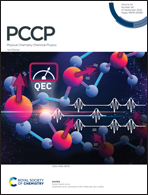Tribochemical synergy between phosphate-intercalated layered double hydroxide additives and super high oleic safflower oil on sliding contacts†
Abstract
In this study, the tribological properties of a series of layered double hydroxides (LDHs) intercalated by various phosphate anions (hydrogen phosphate, orthophosphate, pyrophosphate, and hexametaphosphate) were investigated by ball-on-disc testing in safflower oil which has a super high content of oleic acid (OA). The Mg–Al–NO3− LDH precursor was first synthesized by a coprecipitation method, and then nitrate anions were substituted by different phosphate anions via anion exchange. The successful intercalations were confirmed by X-ray powder diffraction (XRD), Fourier-transform infrared (FTIR) spectroscopy, and scanning electron microscopy/energy dispersive X-ray spectroscopy (SEM/EDS) analysis. The tribological results indicate that the antiwear properties increased linearly with the basic strength of the phosphate anions. Stronger bases, such as orthophosphate (PO43−) and pyrophosphate (P2O74−), encourage the dissociation of OA to form a protective oleate tribofilm on steel surfaces, leading to more than 40% wear reduction compared to the base oil. The tribological performance of the best antiwear candidate, PO43−-LDH, was studied further under different loads and concentrations. A comparison between PO43−-LDH and other nanomaterials was also carried out with PO43−-LDH exhibiting a comparable performance against hexagonal boron nitride (BN).



 Please wait while we load your content...
Please wait while we load your content...